The first (medallion) PMCs from Australia Post
Timeline to the first PMCs
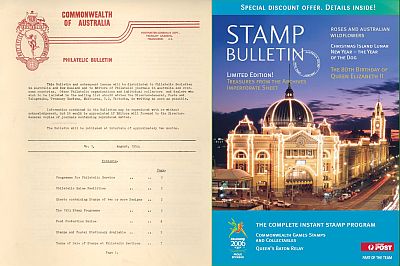
(Image of the first page of the first Philatelic Bulletin and issue 282 of the Stamp Bulletin, courtesy Australia Post)
Firstly, this piece is about the first official Australia Post issued PMC. I am aware of other PMCs issued by other countries / issues back to the 1970s. If anyone has a strong lead on what was THE first PMC anywhere, please do let me know!
To get to the first Australia Post issued Postal Medallic Cover (PMC), let’s have a quick look at the history of philately:
- The first stamp, the “Penny Black”, issued in 1840 and featuring Queen Victoria, is a highly sought after piece of philatelic history. People have been collecting stamps ever since.
- In 1913 the first Commonwealth of Australia stamps were produced, and in 1914 the first Australian King George V stamps were produced. Both of these events were commemorated on Postal Medallic Collectibles – at their respective centenaries.
- In 1953, the Postmaster General’s Office (now Australia Post) formed a philatelic bureau, catering to the needs of stamp dealers and collectors. That year, they also started producing the “Philatelic Bulletin“, and that first issue is still available online (as an image PDF). Today, Australia Post call it the “Stamp bulletin”.
- In 1969 a private company, Nuphil Associates, formed in New Zealand, made the first Postal Numismatic Covers ordered specimen quality 50c pieces from the Royal Australian Mint in Canberra. These were the first dodecagonal 50c pieces and these were the only specimen strikes made. Somewhere between 1,200 – 2,000 were minted, and Nuphil made 1,650 envelopes for the project. The covers were postmarked at the Yarralumla Post Office on 1 September 1969 and then back-stamped at Canberra City on the same day. These are known as “Yarralumla PNCs” and fetch well over $1,000 as of this writing.
- Throughout the 1970s and 1980s, various countries and private companies issued PNCs. In 1994, Australia Post issued the first “official” Australian PNC, commemorating the Year of the Family. That PNC is much more readily available and affordable (and I anticipate a post on it here in due course).
- At various times, Australia Post released medallions. Although the Australia Post’s own collectibles site only has Stamp Bulletin’s back to 2009, the Internet Archive, The WayBack Machine, lists Stamp Bulletin archives back to issue 247, October – December 1998. A couple of interesting issues:
- Issue 253 lists Olympic Mascots medallions.
- Issue 254 lists a Korean War “Maximum Card” with medallions – This is actually what is now called a “Maxicard” – a post card with an image based on the same theme as the current stamp range – in this case Korean War medallions – it’s didn’t actually come with a medallion.
- Issue 259 offered a 1oz Mother’s Day medallion in a box. Issue 260 corrected this to: “Mother’s Day medallion 1113357. Medallion to be mounted on a card in an envelope (not in themed presentation box as previously advised)”. $49.00. But as far as I can tell it didn’t have a stamp, but they didn’t include a picture and I can’t find one online. If anyone has a photo and can please confirm what that item looked like, I would still be interested.
- Finally, issue 282 lists what I believe is the first official Australia Post issued, Postal Medallion Cover.
Obverse

In 2006, the XVIII (18th) Commonwealth Games were held in Melbourne, Victoria, Australia. To commemorate this, Australia post did issue several PNCs (for the baton relay and the games themselves), but for the first time, (that I am aware of) they also issued a “Postal Medallic Cover”, or PMC.
The envelope features an abstract photo of “Fed Square” in the centre of Melbourne. Three stamps, featuring different sports:
- 50c: Crouched runner on a green stamp
- $1.25 International stamp: Cyclist on yellow stamp
- $1.85 International stamp: Netballer on a blue stamp (Netball was introduced to the Commonwealth Games in 1998).
The envelope also features the logo and the three medallions. I have set #1626 of 3,500. At the bottom of the envelope reads “Australia Post is proud to present this limited-edition set of medallions to coincide with the Melbourne 2006 Commonwealth Games.
Reverse
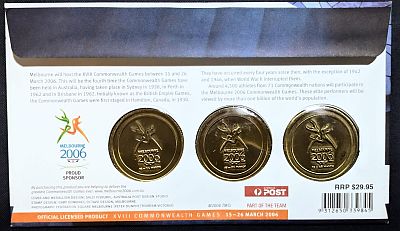
The reverse of the envelope features information about the Commonwealth Games:
“Melbourne will host the XVIII Commonwealth Games between 15 and 26 March 2006. This will be the fourth time the Commonwealth Games have been held in Australia, having taken place in Sydney in 1938, in Perth in 1962 and in Brisbane in 1982. Initially known as the British Empire Games, the Commonwealth Games were first staged in Hamilton, Canada, in 1930.
They have occurred every four years since then, with the exception of 1942 and 1946, when World War II interrupted them.
Around 4,500 athletes from 71 Commonwealth nations will participate in the Melbourne 2006 Commonwealth Games. These elite performers will be viewed by more than one billion of the world’s population.
By purchasing this product, you are helping to deliver the greatest Commonwealth Games ever. www.melbourne2006.com.au (the website no longer exists).
COVER AND MEDALLION DESIGN: SALLY PISKURIC, AUSTRALIA POST DESIGN STUDIO STAMP DESIGN: GARY DOMONEY, OCTAVO DESIGN, MELBOURNE PHOTOGRAPH: FEDERATION SQUARE MELBOURNE (PETER DUNPHY/TOURISM VICTORIA)”
Inner Card
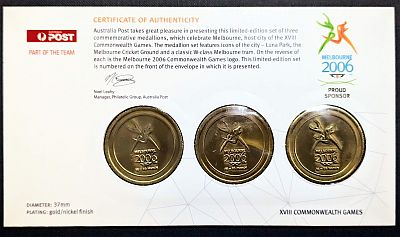
The obverse of the inner card (not pictured) features another abstract photo of Fed Square in blue on the left with the title above the medallions on the right.
The reverse (above) features a certificate of authenticity and details of the medallions which are each 37mm diameter and gold/nickel finish.
The reverse of the medallions and the inner card feature the 2006 Commonwealth games logo – two athletes, one jumping and one running, with the legs forming an “M” above “Melbourne 2006” and the dates “15-26 March”.
The Medallions
The first medallion features the iconic entrance to Luna Park Melbourne, called “Mr Moon”. The giant grinning face first welcomed visitors in 1912:
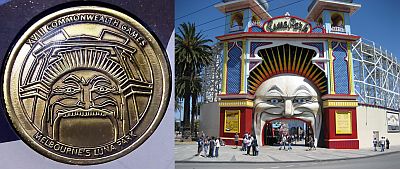
(Image of Luna Park from Wikipedia).
The second medallion features the Melbourne Cricket Ground, the MCG. Established in 1853, less than 20 years after Melbourne itself. It has been the home of Australian football since 1859. It was the birthplace of Test cricket in 1877 and one-day international cricket in 1971. It was the main stadium for the 1956 Olympic Games and 2006 Commonwealth Games

(Image of the MCG from Wikipedia)
The right medallion features one of Melbourne’s iconic W class trams. More than 750 W-Class trams were built from 1923 – 1956. The trams currently run the free “City Circle” service which loops around the city giving interesting information as it goes.
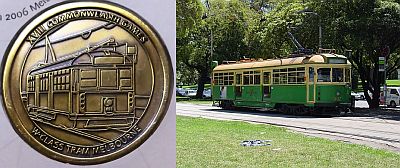
(Image of the W-Class tram from Wikipedia)


Leave a Reply